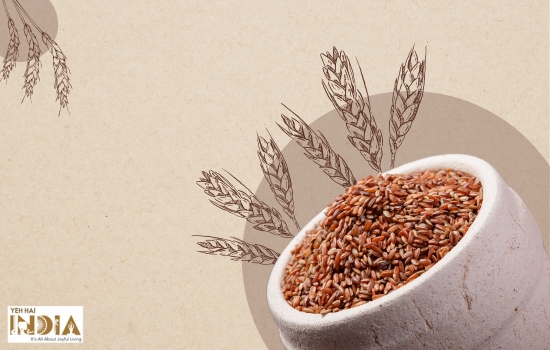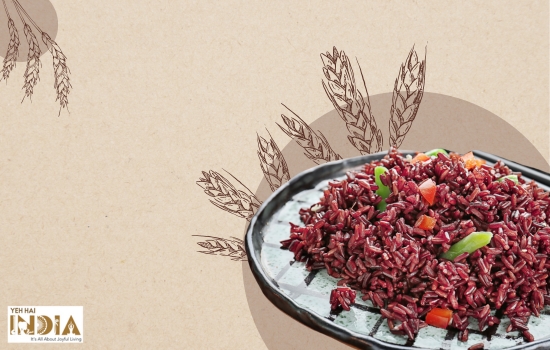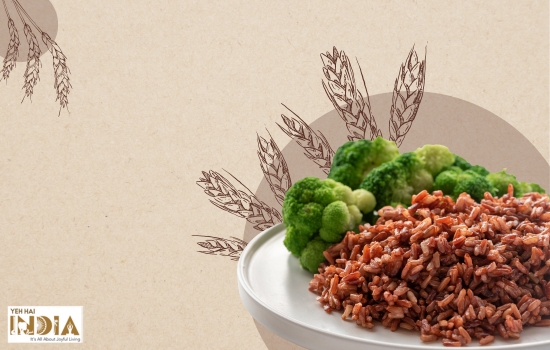Red rice is not just your ordinary rice. It is a vibrant and flavorful whole grain that boasts a beautiful reddish colour thanks to its high levels of anthocyanin pigments. From reducing the risk of chronic diseases to aiding in weight management, the impressive benefits of red rice make it a valuable addition to any diet.
This superfood is packed with essential nutrients and offers a host of health benefits that will leave you feeling amazing.
Why Red Rice?

Red rice is a nutrient-dense whole grain that’s bursting with fibre, vitamins, and minerals that are essential for maintaining optimal health. Its nutty and slightly sweet flavour makes it a versatile ingredient in the kitchen, and it pairs well with a wide range of dishes.
As a low-fat and low-sodium food, it’s an excellent choice for anyone looking to maintain a healthy diet. Red rice is also less processed than its polished white rice counterpart, retaining more of its natural goodness and nutritional value. So if you’re looking to add more variety and nutrition to your meals, try incorporating red rice into your next recipe.
Types of Red Rice:
1. Red Matta Rice:
With its pinkish-red hue and slightly sticky texture, Red Matta Rice is an indigenous variety from Kerala that’s rich in fibre, iron, and other essential minerals. It’s a healthy and nutritious option that’s perfect for those looking to add more variety to their diet.
2. Chak Hao Amubi Rice:
Grown in Manipur, Chak Hao Amubi Rice has a deep red colour and a distinct aroma. It’s often used in local dishes, such as sweet pudding made with milk and jaggery. This variety of red rice is also rich in antioxidants and has anti-inflammatory properties.
3. Lal Qilla Red Rice:
Lal Qilla Red Rice is a premium quality basmati rice that’s grown in the Himalayan foothills. With its nutty flavour and beautiful reddish-brown colour, it’s a healthy and nutritious option that’s low in fat and high in fibre.
4. Red Sona Masoori Rice:
Popular in southern India, Red Sona Masoori Rice is a delicate and fluffy variety that’s rich in fibre and other essential nutrients. It’s perfect for those looking for a healthy and satisfying addition to their meals.
5. Bamboo Rice:
Bamboo Rice is a rare and unique variety that’s harvested from the seeds of bamboo flowers. With its distinctive flavour and reddish-brown colour, it’s a healthy and nutritious choice that’s rich in fibre, protein, and other essential nutrients. It’s also believed to have medicinal properties and is used in traditional Ayurvedic medicine.
Red Rice Nutrition Profile
Red rice is like a superhero of nutrition, jam-packed with all sorts of good stuff to keep you healthy. It’s got protein, carbs, healthy fats, and loads of vitamins and minerals like zinc and iron. Plus, it’s chock-full of antioxidants like anthocyanins and flavonoids to fight off bad guys like free radicals.
With 356 kCal of energy per 100 g, 11.10 g of fibre, 8.89 g of protein, and just 3.33 g of fat, red rice is the perfect sidekick for any meal.
Recommended Article: Beat the Heat – Shilpi’s Tips to Stay Hydrated This Summer
Health Benefits of Red Rice
Red rice is a variety of rice that has been gaining popularity in recent years due to its numerous health benefits.

Here are five benefits of red rice:
1. High in antioxidants: Red rice contains a high level of antioxidants that can help protect your body from damage caused by free radicals.
2. Good for your heart: Red rice is known to lower cholesterol levels in the body, which can help reduce the risk of heart disease.
3. Helps with digestion: Red rice is rich in fibre, which can help promote healthy digestion and prevent constipation.
4. Boosts energy: Red rice contains complex carbohydrates that provide a steady release of energy, making it a great food for athletes and active individuals.
5. May help prevent cancer: Red rice contains antioxidants that have been shown to have anti-cancer properties and may help prevent the development of cancer cells.
6. Supports bone health: Red rice is rich in minerals like magnesium, phosphorus, and zinc, which are essential for maintaining healthy bones.
7. May reduce inflammation: The antioxidants found in red rice may help reduce inflammation in the body, which can help prevent chronic diseases.
8. Supports brain health: Red rice contains vitamins and minerals like vitamin B6 and iron that are important for brain function and may help improve cognitive function.
9. May improve blood sugar control: Red rice has a low glycemic index, which means it can help regulate blood sugar levels and may be beneficial for individuals with diabetes.
10. Supports weight loss: Red rice is a low-calorie food that can help you feel full for longer, making it a great addition to any weight loss plan.
Recommended Article: From Hive to Home: 10 Best Honey Brands in India
Caution!!
You know what they say about too much of a good thing. Despite its many benefits, red rice may also have some side effects on rare occasions. Here are a few to be aware of:
1. Allergic reactions: Some people may be allergic to red rice, so it’s important to check for any signs of an allergic reaction before consuming it.
2. Digestive issues: Red rice is high in fibre, which can cause digestive issues such as bloating and gas on overindulgence and in people prone to such digestive issues.
3. Interaction with medication: Red rice may interact with certain medications, so it’s important to speak with your doctor before consuming it if you’re taking any prescription medication.
Overall, red rice is a nutritious and delicious food that can provide numerous health benefits and it is better to consume it in moderation as part of a balanced diet.
How to Cook Red Rice?

Cooking red rice is easy-peasy and will add some pizzazz to your meals. Here’s how to do it:
1. Rinse the rice in cold water to remove any debris.
2. Soak the rice in water for at least 30 minutes before cooking.
3. For every cup of rice, add two cups of water to a pot.
4. Bring the water to a boil and reduce the heat to low.
5. Cover the pot with a lid and let the rice simmer for 20-30 minutes.
6. Check the rice occasionally to ensure it’s not sticking to the bottom of the pot.
7. Once the rice is cooked, remove it from the heat and let it sit covered for 5-10 minutes.
8. Fluff the rice with a fork before serving.
Pro tip: For extra flavour, try cooking your red rice in vegetable broth instead of water. You can also add herbs or spices like bay leaves, thyme, or turmeric to the cooking water to give the rice an extra kick.
Recommended Article: Quinoa: A much healthier alternative to Rice
Now that you know how to cook red rice, go ahead and give it a try! It’s a versatile and nutritious ingredient that can be used in a variety of dishes. So get creative in the kitchen and enjoy the vibrant colours and flavours of this delicious whole grain.
Frequently Asked Questions?
1. Is red rice better than white rice?
Red rice is generally considered to be healthier than white rice because it’s less processed and retains more of its natural goodness and nutritional value. Red rice also contains more fibre and antioxidants than white rice.
2. Can red rice help with weight loss?
Yes, red rice can help with weight loss because it’s low in calories and high in fibre, which can help you feel full for longer.
3. How do you store red rice?
To store red rice, place it in an airtight container and store it in a cool, dry place away from direct sunlight. Red rice can also be stored in the refrigerator or freezer for longer shelf life.
4. How long does it take to cook red rice?
The cooking time for red rice varies depending on the variety and the method of cooking. Generally, it takes around 30-40 minutes to cook red rice on the stove, and around 20 minutes in a rice cooker.
In conclusion,
Red rice is not just a colourful and flavorful whole grain, but also a nutritious superfood that offers various health benefits. From being high in antioxidants and good for your heart to helping with digestion and boosting energy, it’s an excellent addition to any diet.
While there may be some potential side effects, consuming red rice in moderation can be a great way to add variety and nutrition to your meals. So why not try incorporating red rice into your next recipe and see how it can benefit your health?
Also Read: Nutrition Bowls: A Guide To Make Your Own Mini-Meal











This was really helpful!